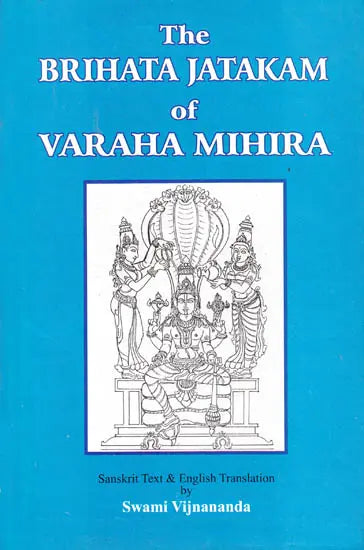The Brihata Jatakam of Varaha Mihira (Sanskrit Text and English Translation)
The Brihata Jatakam of Varaha Mihira (Sanskrit Text and English Translation) is backordered and will ship as soon as it is back in stock.
Couldn't load pickup availability
Genuine Products Guarantee
Genuine Products Guarantee
We guarantee 100% genuine products, and if proven otherwise, we will compensate you with 10 times the product's cost.
Delivery and Shipping
Delivery and Shipping
Products are generally ready for dispatch within 1 day and typically reach you in 3 to 5 days.
Book Title: Brihata Jatakam of Varaha Mihira
-
Author: Swami Vijnananda
-
Language: Sanskrit Text, Word-to-Word Meaning, English Translation, and Explanation
-
Pages: 403
-
Cover: Hardcover
-
Dimensions: 23 cm x 14.5 cm
-
Weight: 570 gm
-
Edition: 2008
-
ISBN: 8170308739
Book Description
From the Jacket:
-
The Brihata Jatakam of Varaha Mihira is one of the best treatises on astrology, focusing on the practice of Jataka (horoscopy), a branch of astrology.
-
This volume covers a wide range of topics, including:
-
Zodiacal signs and planets
-
Manifold births, impregnation, and birth matters
-
Early death, length of life, and death
-
Dasas and Antardasa
-
Astaka Varga and Raja Yoga
-
Nabhasa Yogas, Lunar combinations, and Ascetic Yogas
-
The Moon and the Zodiac, aspects, and planetary combinations
-
Female horoscopes and lost horoscopes
-
-
The book also features an appendix and an index to the verses for further reference.
Foreword:
-
Jyotisha Shastra, the science of astrology, is one of the six branches of the Vedas. Astrology, known as the eye of the Vedas, guides the religious rites and sacrifices of Hindus.
-
The foreword traces the origins of astrology back to the Vedic period and its spread to China, Babylon, Egypt, Greece, and Rome.
-
It emphasizes the connection between stars and human souls, noting that souls of the greatest individuals become stars.
-
Astrology is based on two main principles:
-
The Vedantic understanding that the universe is a unified system, with laws operative in both the macrocosm (the heavens) and microcosm (humanity).
-
The second principle suggests that by studying the positions of planets, one can observe and measure these cosmic laws.
-
-
The foreword discusses the role of astrology in understanding past karma, predicting the future, and guiding human actions in harmony with fate.
-
It also provides an introduction to Varaha Mihira, one of the greatest astrologers in Indian history, known for his work on astrology, astronomy, and yoga.





